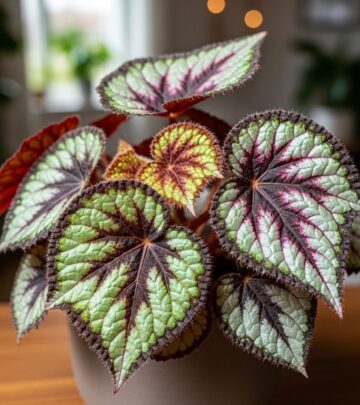Purple Peony Varieties: 11 Gorgeous Picks For Your Garden
Transform your landscape with bold, fragrant purple peonies — discover the best varieties and expert care tips for thriving blooms.

Image: HearthJunction Design Team
11 Gorgeous Purple Peony Varieties for Your Flower Garden
Few flowers can rival the sheer opulence and charm of peonies, and purple-hued varieties add an extra layer of depth and intrigue to any landscape. From soft lavender shades to rich, wine-colored blossoms, purple peonies make an unforgettable statement. In this guide, you’ll discover 11 striking purple peony varieties, complete with descriptions, growing tips, and essential care advice to keep your blooms thriving season after season.
Why Choose Purple Peonies?
Purple peonies are increasingly popular among garden enthusiasts and landscape designers for a variety of reasons:
- Unique Color Palette: Shades of purple are less common in peonies, making them standout choices in mixed borders.
- Fragrance: Many purple peony types are highly scented, filling your garden with sweet, memorable aromas.
- Long Blooming: With proper care, these perennials offer weeks of springtime display.
- Dramatic Impact: Ranging from subtle lilacs to velvety purples and magentas, purple peonies provide stunning contrast against greens and lighter blooms.
11 Purple Peony Varieties to Grow
1. ‘Cardinal Vaughan’
Species: Hybrid Tree Peony
Height: 4-5 feet
Bloom Time: Late spring
‘Cardinal Vaughan’ boasts large, magenta-purple petals with a soft, velvety appearance. This tree peony variety stands out with its upright habit and robust stems. While the foliage is lush green, the deep purple flowers create a regal focal point in early to mid-spring gardens.
2. ‘Cora Louise’
Species: Itoh Hybrid
Height: 2-3 feet
Bloom Time: Late spring to early summer
This Intersectional (Itoh) peony features semi-double to double blooms with striking white petals washed with lavender to purple at the base. ‘Cora Louise’ is prized for its unique bicolor effect and robust, disease-resistant foliage.
3. ‘First Arrival’
Species: Itoh Hybrid
Height: 2-3 feet
Bloom Time: Early spring
As the name suggests, ‘First Arrival’ is among the earliest blooming intersectional peonies. The blooms open in soft pink-lilac and age to a dreamy lavender-purple with subtle yellow centers, often drawing pollinators to the garden.
4. ‘Pastel Splendor’
Species: Itoh Hybrid
Height: 2 feet
Bloom Time: Mid to late spring
This compact peony delivers semi-double blossoms in a painterly gradient of lavender-pink and cream, with noticeable streaks of purple. ‘Pastel Splendor’ is perfect for smaller spaces or as part of a mixed perennial border.
5. ‘Visions of Sugar Plums’
Species: Itoh Hybrid
Plant Type: Hybrid Deciduous Perennial
Geographic Origin: United States
Plant Size: 2-3 feet tall
Sun Exposure: Partial to full sun
Hardiness Zone: 4-7
‘Visions of Sugar Plums’ features large, six-inch flowers with creamy white petals edged and streaked in delicate purple. The colors intensify and evolve as the blooms mature, transitioning from pale pinks to more vivid violet and purple accents. This variety is well-suited for colder climates and blooms reliably in spring when provided with adequate sun and drainage.
6. ‘Morning Lilac’
Species: Itoh Hybrid
Height: 2-3 feet
Bloom Time: Late spring
‘Morning Lilac’ boasts eye-catching, magenta-purple blooms with fluted petals and bright yellow centers. The blooms are large, fragrant, and ideal for cut flower arrangements.
7. ‘Royal Purple’
Species: Herbaceous Peony
Height: 2-3 feet
Bloom Time: Mid-spring
This peony variety is known for its rich, deep purple coloring. The lush, ruffled petals are densely packed, giving each bloom a full and extravagant appearance. It makes a dramatic addition to any flower bed.
8. ‘Purple Spider’
Species: Tree Peony
Height: 3-4 feet
Bloom Time: Early spring
‘Purple Spider’ features unique, spidery petals in a radiant, vibrant purple. The unusual flower form and intense color make it a conversation piece in any landscape.
9. ‘Hei Bao’ (Black Panther)
Species: Tree Peony
Height: 3-4 feet
Bloom Time: Mid to late spring
This rare Chinese variety is prized for its dark, velvety purple, almost black petals reminiscent of a panther’s fur. The enormous, double blooms are dramatic and deeply exotic.
10. ‘Lavender’
Species: Herbaceous Peony
Height: 2-3 feet
Bloom Time: Late spring to early summer
With soft lavender to pastel purple petals, this variety offers subtle elegance. ‘Lavender’ is excellent for mass planting or as a gentle complement to brighter blooms.
11. ‘Kamada Nishiki’
Species: Tree Peony
Height: 3-5 feet
Bloom Time: Mid-spring
Originating from Japan, ‘Kamada Nishiki’ produces large, single to semi-double flowers in rich reddish-purple. The plants are robust, reliable, and flourish in partially shaded gardens.
Table: Quick Comparison of Purple Peony Varieties
| Variety | Type | Bloom Color | Bloom Time | Height |
|---|---|---|---|---|
| Cardinal Vaughan | Tree Peony | Magenta-purple | Late spring | 4-5 ft |
| Cora Louise | Itoh Hybrid | White with purple base | Late spring | 2-3 ft |
| First Arrival | Itoh Hybrid | Lavender-pink | Early spring | 2-3 ft |
| Pastel Splendor | Itoh Hybrid | Lavender-pink/purple streaks | Mid-late spring | 2 ft |
| Visions of Sugar Plums | Itoh Hybrid | White with purple accents | Spring | 2-3 ft |
| Morning Lilac | Itoh Hybrid | Magenta-purple | Late spring | 2-3 ft |
| Royal Purple | Herbaceous | Deep purple | Mid-spring | 2-3 ft |
| Purple Spider | Tree Peony | Vibrant purple | Early spring | 3-4 ft |
| Hei Bao | Tree Peony | Dark purple | Mid-late spring | 3-4 ft |
| Lavender | Herbaceous | Lavender | Late spring | 2-3 ft |
| Kamada Nishiki | Tree Peony | Reddish-purple | Mid-spring | 3-5 ft |
How to Grow and Care for Purple Peonies
To ensure your purple peonies flourish and produce their signature blooms, follow these tried-and-true cultivation and care tips:
Site and Soil Requirements
- Light: Purple peonies require at least six hours of direct sunlight daily. More sun typically results in more abundant blooms, but partial shade is tolerated.
- Soil: Plant in fertile, well-draining soil. Amending with compost at planting time is highly recommended for robust growth.
Planting Tips
- Timing: Plant peony bare roots or potted starts in the fall for best results, giving roots time to establish before winter.
- Depth: Set the crown of the peony (where the stem meets the root) just below soil level—about 1–2 inches deep. Planting too deep often prevents blooming.
- Spacing: Allow ample space (2–3 feet per plant) for airflow and mature spread, minimizing the risk of fungal issues.
Watering and Fertilizing
- Water: Keep the soil evenly moist during the growing season. Avoid soggy soil as peonies are prone to root rot.
- Fertilizer: Apply a balanced fertilizer or bone meal in early spring, prior to budding. Too much nitrogen can reduce blooms and weaken stems.
Support and Maintenance
- Staking: Many peony varieties benefit from staking or grow-through supports to prevent flopping when in heavy bloom.
- Deadheading: Remove faded blooms to direct energy back into the roots.
- Pruning: Cut back stems and foliage in fall to reduce disease risk and keep the plants tidy for winter.
Winter Care
- Apply a layer of mulch after the first hard frost in late fall to protect roots (especially in colder zones).
- Remove mulch in spring just as new shoots emerge.
Benefits of Growing Purple Peonies
- Stunning, long-lasting blooms bring color and fragrance to spring gardens.
- Excellent as cut flowers for bouquets and arrangements.
- Attract pollinators such as bees and butterflies.
- Many varieties are drought-tolerant and deer resistant once established.
- Perennial longevity—some peony clumps can thrive for 50 years or more!
Design Ideas: Using Purple Peonies in Your Landscape
- Mixed Borders: Interplant with pale pink, white, or yellow perennials for vibrant contrast.
- Foundation Plantings: Use as dramatic anchors near entrances or in front-yard beds.
- Cutting Gardens: Plant rows of purple peonies for reliable spring bouquets.
- Shade Gardens: Many tree and Itoh peonies tolerate morning sun and afternoon shade, adding elegance to woodland edges.
- Single Specimen: Let a bold purple peony steal the show in a prominent pot or center-bed position.
Frequently Asked Questions (FAQs)
Q: Do all peonies come in purple shades?
A: While most peonies are found in pink, white, or red, there are several varieties with purple, lavender, or wine-hued blooms, especially among tree and Itoh (intersectional) hybrids.
Q: How long does it take for a newly planted purple peony to bloom?
A: Peonies are slow to establish and can take 2–3 years (or longer) to produce abundant blooms. Patience is key—the plants get better with age and rarely need division.
Q: Can I grow purple peonies in containers?
A: Some smaller varieties, especially Itoh hybrids, can be grown in large, deep containers. Ensure excellent drainage and overwinter the pots in a sheltered area if you’re in a cold region.
Q: What is the best time to plant purple peonies?
A: Fall is the optimal season to plant bare-root peonies, as this allows roots to develop before winter dormancy. Spring planting is possible, but plants might take longer to establish.
Q: Are purple peonies deer or pest resistant?
A: Most peonies, including purple types, are unappealing to deer and fairly pest-resistant. However, ants are often attracted to the flower buds (they do no harm) and good airflow is necessary to prevent fungal diseases.
Final Thoughts
Purple peonies are truly the jewels of the spring perennial garden. With their unique shades, lavish blooms, and sweet fragrance, they transform any landscape into a sophisticated, colorful retreat. Most purple peony varieties are easy to grow, requiring only full sun, well-draining soil, and a bit of seasonal maintenance. Whether you’re a new gardener or an experienced enthusiast, planting one or more of these varieties will enrich your outdoor space for decades to come. Choose your favorites, give them the proper care, and enjoy a spectacular show of blooms year after year.
References
Read full bio of Anjali Sayee












